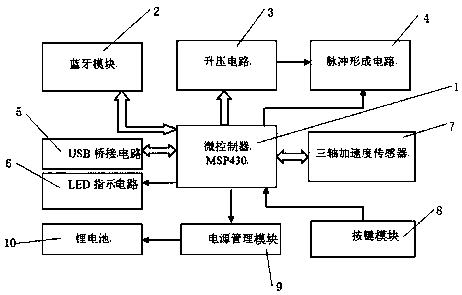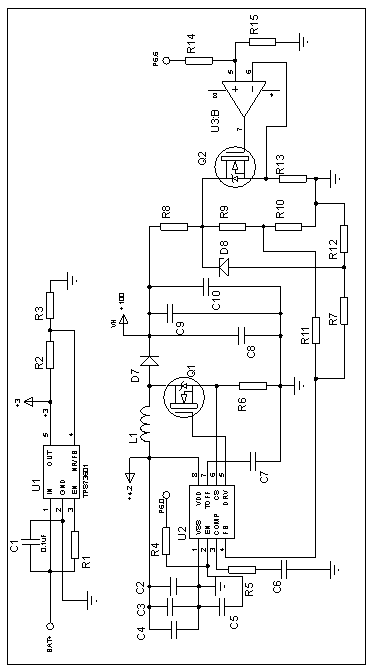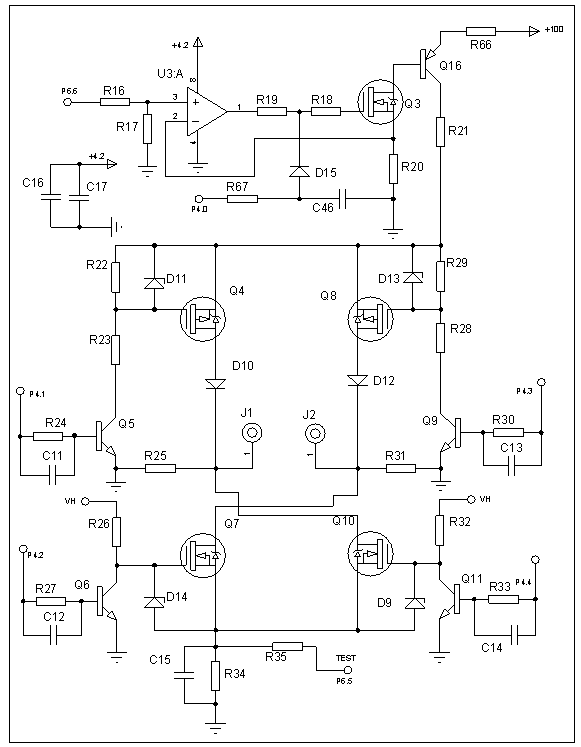Hardware circuit of pain electric pulse therapy instrument
A hardware circuit and therapeutic device technology, applied in the field of medical systems, can solve problems such as inconsistent electrical stimulation responses, interruption of pain information transmission, and inability to output specific electrical pulse signals.
- Summary
- Abstract
- Description
- Claims
- Application Information
AI Technical Summary
Problems solved by technology
Method used
Image
Examples
Embodiment 1
[0028] Embodiment 1: A hardware circuit of a pain electric pulse therapy instrument, at least including a microcontroller 1, a Bluetooth module 2, a boost circuit 3, a pulse forming circuit 4, a USB bridge circuit 5, an LED indicating circuit 6, and a power management module 9 , button module 8, triaxial acceleration sensor 7 and lithium battery 10, it is characterized in that: described microcontroller 1 output terminal is respectively connected bluetooth module 2, step-up circuit 3, pulse forming circuit 4, USB bridging circuit 5, LED indication Circuit 6, power management module 9, button module 8, input terminal of triaxial acceleration sensor 7, wherein output terminal of boost circuit 3 is connected to input terminal of pulse forming circuit 4, output terminal of power management module 9 is connected to input terminal of lithium battery 10, power management The lithium battery 10 in the module 9 supplies power to each module circuit, the power management module 9 supplie...
Embodiment 2
[0031] Such as Figure 8 As shown, the microcontroller 1 adopts a single-chip microcomputer whose model is MSP430.
[0032] Select power management and microcontroller 1 core devices with extremely low power consumption. In the design of the circuit part, the MSP430F169IPM with low operating voltage and low power consumption in the MSP430 series microcontroller 1 product family is selected as the core control chip of this product. At the same time, the ultra-low dropout and ultra-low power consumption power supply chip TPS73601DBVT is selected to realize power management. This chip can work under extremely low input-output pressure difference, and its own power consumption is extremely low. For other peripheral circuits, the microcontroller 1 controls the on-off of the MOS tube to realize the dynamic management of the power supply, and only supplies power when the relevant unit circuits are working.
Embodiment 3
[0034] Such as figure 2 and Figure 8 As shown, the boost circuit 3 uses a TPS73601 single-chip microcomputer, the circuit is connected to the microcontroller 1 through the P6.6 pin, and the P6.0 port of the microcontroller 1 transmits the control signal to the U2 chip in the boost circuit 3 .
[0035] Under the control of the microcontroller 1, the boost circuit 3 generates PWM output from a dedicated DC-DC boost chip, which excites the high-frequency power MOS boost tube, and passes through components such as energy storage inductors, fast recovery rectifier diodes, and energy storage filter capacitors. , to output a suitable voltage under the control of the microcontroller 1 to supply power to the pulse forming circuit 4 .
[0036] The LDO chip U1 is the core chip of the power management module 9. Due to the limited capacity of the battery, the output voltage will gradually decrease with the prolongation of the use time. Choose TPS73601 as the LDO chip, the voltage regul...
PUM
 Login to View More
Login to View More Abstract
Description
Claims
Application Information
 Login to View More
Login to View More - R&D
- Intellectual Property
- Life Sciences
- Materials
- Tech Scout
- Unparalleled Data Quality
- Higher Quality Content
- 60% Fewer Hallucinations
Browse by: Latest US Patents, China's latest patents, Technical Efficacy Thesaurus, Application Domain, Technology Topic, Popular Technical Reports.
© 2025 PatSnap. All rights reserved.Legal|Privacy policy|Modern Slavery Act Transparency Statement|Sitemap|About US| Contact US: help@patsnap.com



